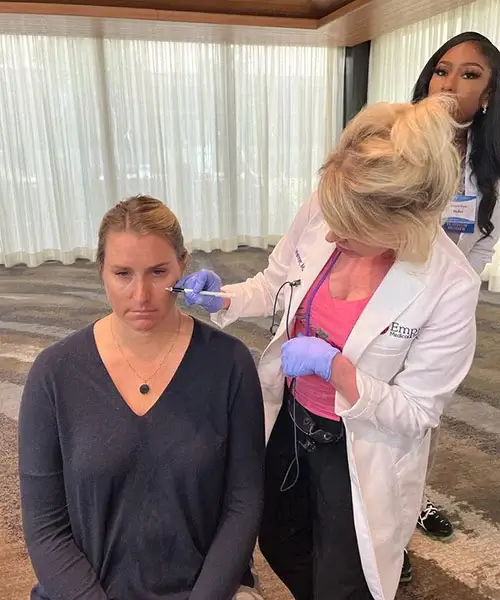Demystifying Face Wrinkles: What Do They All Mean
By Dr. Stephen Cosentino
PRESIDENT OF EMPIRE MEDICAL TRAINING
Many different types of wrinkles affect the face. They become more common as we age, prompting two questions:
- Why do face wrinkles happen?
- What can be done about them?
Let’s answer both of these questions. We’ll begin with the main types of face wrinkles and their root causes.
Types of Facial Wrinkles & What They Mean
Face lines and wrinkles become more common (and deeper) with age, but they don’t all have the same cause. The most noticeable are:
- Horizontal forehead lines: These lines appear whenever you arch your eyebrows. Over time, they tend to get “stuck” in that position, lending a world-weary look.
- Glabellar lines: Also known as frown lines or “11” lines, these vertical lines appear between the eyes and eyebrows above the bridge of the nose. They deepen and lengthen over time, even when you’re not frowning.
- Crow’s feet: Officially known as lateral canthal lines, and popularly as smile lines and laugh lines, these are very fine lines that radiate outward from the outer corners of the eyes.
- Nasolabial folds: Confusingly, these are also known as laugh lines. They extend downward from the lower bridge and base of the nose and sometimes form a cup or parenthesis shape around the mouth. They can become very deep and noticeable over time.
- Marionette lines: These lines extend downward from the corners of the mouth, framing the chin. They sometimes appear as extensions of nasolabial folds, and like those can become quite deep over time.
- Bunny lines: These slanted lines appear when you scrunch your nose. Like other fine lines around the face, they can get “stuck” over time, creating permanent furrows on the bridge of the nose.
What Causes Wrinkles?
Most facial wrinkles fall into one of two categories: dynamic wrinkles and static wrinkles.
The two are related. Dynamic wrinkles tend to appear and deepen over time in response to repeated facial movements. Most of the wrinkles described above have dynamic origins.
Static wrinkles also appear and deepen over time, but they’re influenced more by environmental factors (like sun exposure and smoking) and genetics than by specific facial expressions. However, dynamic factors can accelerate their onset and worsen them over time.
Environmental Factors
Sun exposure is one of the primary environmental contributors to wrinkle formation. The ultraviolet (UV) radiation from the sun damages the skin's collagen and elastin fibers, causing them to break down prematurely. This leads to a loss of skin elasticity and the development of fine lines and wrinkles, particularly on sun-exposed areas like the face, neck, and hands.
Smoking is another major environmental factor that accelerates skin aging and wrinkle development. The chemicals in cigarette smoke, such as nicotine and free radicals, damage the skin's structural proteins and impair the skin's ability to repair itself. Smokers tend to develop deeper wrinkles, especially around the mouth, at a faster rate than non-smokers.
Other environmental stressors, such as air pollution, harsh weather conditions, and repeated facial expressions, can also contribute to wrinkle formation over time. These factors can all lead to an increase in oxidative stress and inflammation, which further break down the skin's collagen and elastin.
Intrinsic Aging and Genetics
In addition to environmental factors, intrinsic aging and genetics play a significant role in wrinkle development. As we grow older, our skin naturally loses its elasticity and the production of collagen and elastin slows down. This leads to the formation of static wrinkles, which are present even when the face is at rest.
Some individuals are genetically predisposed to developing wrinkles earlier than others. Certain genetic variations can affect the skin's ability to produce and maintain collagen and elastin, leading to a more rapid breakdown of these structural proteins. This can result in the appearance of wrinkles at a younger age, even in the absence of significant environmental damage.
Dynamic Wrinkles and Facial Expressions
Facial expressions and muscle movements are a major contributor to the formation of dynamic wrinkles. Repeated contractions of the facial muscles, such as squinting, frowning, or smiling, create creases and lines in the skin that eventually become etched in over time.
For example, the repeated contraction of the muscles around the eyes leads to the development of crow's feet, while the furrowing of the brow creates the vertical "11" lines between the eyebrows. These dynamic wrinkles are initially only visible during facial expressions, but as the skin loses its elasticity, they can become permanent, even when the face is at rest.
By understanding the various factors that contribute to wrinkle formation, individuals can take proactive steps to protect their skin and delay the onset of visible signs of aging.
Treatment Options for Face Wrinkles
A disciplined skin care routine can delay the appearance of both static and dynamic wrinkles. But age catches up to us all, and sooner or later, more aggressive interventions are warranted.
There are several minimally invasive treatment options for face wrinkles, but let’s take a look at three of the most popular: botulinum toxin injections, dermal fillers, and PDO thread lifts.
The treatment you select will largely depend on whether you have fine lines or deep wrinkles.
Fine lines are the early signs of wrinkle formation - they are shallow, light creases in the skin that appear when the face is in motion, such as when smiling or furrowing the brow. They are less noticeable and embedded less deeply in the skin compared to deep wrinkles. And many people with fine lines opt for topical treatments like hyaluronic acid.
Deep wrinkles, on the other hand, are more pronounced, permanent grooves in the skin that remain visible even when the face is at rest. They develop over time as the skin loses elasticity and collagen due to factors like aging, sun damage, and repeated facial expressions. For deep wrinkles, your best option is usually a more aggressive approach.
Let’s take a look at the most popular options:
Botulinum Toxin Injection (Botox®)
This is the most popular medically supervised treatment for face wrinkles, so it’s no surprise that some of the most popular Botox injection sites coincide with the expected locations of the wrinkle types described above. Results typically last three to six months.
Dermal Fillers
Dermal fillers offer longer-lasting results but aren’t appropriate for all wrinkle types. The most common dermal filler formulations use hyaluronic acid as the active ingredient; calcium hydroxylapatite (CaHA) is indicated for nasolabial folds and some other wrinkle types. Results can last six months to two years or longer, depending on the location and formulation.
Thread Lifts
Thread lifts use dissolving medical threads, sometimes alongside dermal fillers, to tighten the skin and reduce the appearance of wrinkles and lines. Results typically last six to 12 months but vary based on patient-specific factors.
Getting the Best Results
The key is to address fine lines early on through preventative measures, while deeper wrinkles may require a multi-pronged approach involving both minimally invasive procedures and ongoing skincare. The specific treatment plan should be tailored to the individual's skin type and degree of wrinkle severity. Consulting with a qualified dermatologist or plastic surgeon is the best way to develop a comprehensive plan to address wrinkles and achieve the desired aesthetic results.


